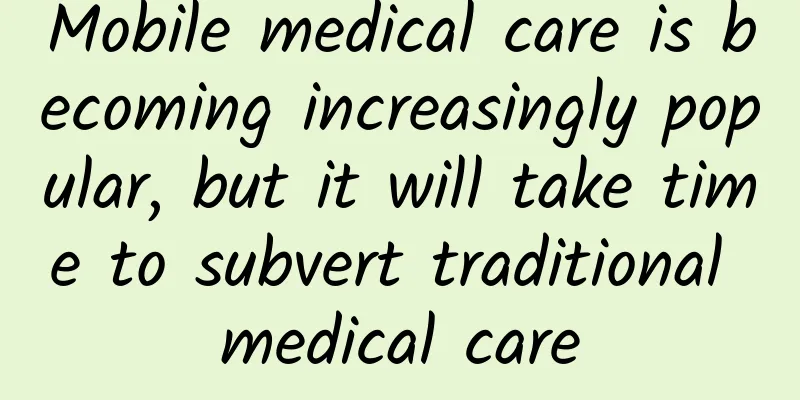Mobile medical care is becoming increasingly popular, but it will take time to subvert traditional medical care

|
The device checks Trellini's blood pressure several times a day and sends the data to a smartphone app, which sends the readings to his doctor. Trellini says the device, made by personal health management startup iHealth, has saved him several doctor's visits. Portable blood pressure monitors have been around for a while, but the idea of connecting a small wearable device to a smartphone and a software app is a great example of how entrepreneurs are using wireless technology to build innovative services. The goal of the mobile medical industry is not only to give doctors and caregivers the ability to remotely monitor patients' conditions and simplify the collection of large amounts of treatment effectiveness data, but also to reduce treatment costs while improving patient treatment outcomes. Emerging markets have already started several trials, and the emergence of new mobile devices and applications is easing the pressure on underfunded and outdated clinics and hospitals. However, the biggest beneficiary of the rise of mobile health is not emerging countries, but the United States. Due to inefficiencies, the US health system spends $2.8 trillion a year. Passionate entrepreneurs have changed the outlook for health care. According to Mercom Capital Group, a global clean energy communications and consulting company, venture capitalists invested a total of $2.2 billion in health care startups last year, of which $564 million went to mobile health companies. The mobile health market can be divided into two categories. The first category of products is to monitor the wearer's physical fitness through applications and electrical devices, such as Nike, fitness accessories manufacturers Fitbit and Jawbone. They install various chips in wristbands and other wearable electronic devices, allowing users to use these devices to record their physical performance and calorie consumption while walking on the street or sweating in the gym. The second category of products is other applications and devices that connect patients’ physical conditions to the medical system. For example, last month, Google announced that it is developing a contact lens with tiny wireless chips and sensors that can detect and transmit blood sugar levels in the tears of diabetics. Apple was awarded a patent for an embedded heart rate monitor in December last year. Health apps may help people maintain their exercise plans and, in time, make them healthier. But in the short term, they won't have a big impact on the health system, and they may not make many investors rich. Research firm IMS Health said that in the Google Play app store, there are more than 33,000 health-related apps, and 15% of the total downloads of these apps come from five apps, two of which are calorie-counting apps. More and more entrepreneurs believe that the second category of products that seek to change the current medical model can make a lot of money. Of course, it is not only start-ups that are eyeing this "fat piece of meat", but large companies have also discovered the business opportunities. Qualcomm has established a mobile medical department, Qualcomm Life, and established a technology platform that allows mobile medical companies to more conveniently integrate data such as people's medication and self-test results, so that doctors can obtain more complete health information from users. In addition, many mobile medical companies have already started selling products. AliveCor has launched a mobile heart monitor priced at $199. The device is connected to the user's smartphone. The user only needs to place two fingers on the metal sheet of the monitor to measure the electrocardiogram by themselves. After the measurement, the data will be displayed in the mobile app and can be transmitted to a cardiologist for evaluation, of course, this will be paid. In addition to this mobile heart monitor, the company also sells a veterinary animal electrocardiogram tester. Another startup, mobile medical diagnostic company CellScope, has launched an otoscope that can be connected to the iPhone and app and transmit the obtained images directly to the physician. Medtronic, a major medical device manufacturer, spent $200 million last year to acquire Cardiocom, a disease management and patient monitoring service provider. In October last year, mobile telecom operator Verizon launched a platform that allows users to transfer data stored in home devices such as home blood glucose meters to the company's cloud servers. As Don Jones, vice president of Qualcomm Life, said, it's like an electronic device in a car telling the driver the condition of the car. Mobile medical devices and applications "give people dashboards, measuring instruments and warning lights" so that users and their doctors can more easily track their physical condition. Users may receive warnings before their health deteriorates and they are hospitalized. The average charge for a hospital ward in the United States is about $4,300 per night. Given such high costs, mobile medical care will be able to save patients a lot of money. Another way to use technology to avoid health crises is to check whether patients are taking their medication. Propeller Healt, a mobile health management platform, has launched a device that is installed above the asthma inhaler to detect the patient's usage. In addition, mobile medical company Proteus Digital Health is testing a digestible electronic chip for medicines. After swallowing the pills, the chip can react with gastric juice to form a loop, and then transmit the information to the smartphone, allowing doctors and caregivers to track the patient's medication time. In any case, the goal of mobile health is to save money while improving the health of users. The average annual treatment cost for patients with hypertension who fail to take their medication is close to $4,000, which is higher than the average treatment cost for patients with hypertension who take their medication on time. If mobile medical products can deliver on their promises to patients, a large number of technology-related medical jobs will disappear, and a large number of medical technicians may face unemployment. The continuous development of machine intelligence may eventually mean that people will rely less on doctors and experts to analyze medical test results. But the problem is that the enthusiasm of technology personnel for this kind of innovation is diametrically opposed to the conservatism of the medical industry. The income of American doctors is proportional to the number of patients they see. Mobile medical products will lead to a decrease in the number of paying patients. Therefore, the traditional medical industry is still skeptical about such products. In addition to reducing doctors' workload, insurance companies may worry that the popularity of mobile medical devices and applications may cause people to think they are sick. As long as there is any irregular data, people will worry about their health, and finally the hospital's treatment rooms will be crowded with various "hypochondriasis" patients. If this happens, the workload of doctors will not be reduced, but will be even busier, and the rising medical costs will not be curbed. Therefore, if mobile medical companies want doctors, hospital managers, and insurance companies to accept mobile medical care, they need to provide evidence to prove that they can indeed reduce medical costs while improving patient treatment outcomes. Stephen Kraus, a partner at Bessemer Venture Partners, a private venture capital firm, said that many mobile medical companies are optimistic that all you have to do is "appify" medical care, and then the world will change. Bob Kocher, a partner at venture capital firm Venrock, believes that many precision mobile medical product manufacturers target doctors, clinics and hospitals rather than patients. If this is the case, they must build a sales force like a pharmaceutical company. It is time-consuming and costly. Some other mobile medical devices may need to be approved by the U.S. Food and Drug Administration (FDA). Last year, the FDA announced a plan to regulate only mobile medical products that have traditional medical device functions, such as electrocardiograms (ECGs). Even so, obtaining FDA approval still requires a complicated process. Despite the difficulties, there are still optimists who believe that the medical industry is undergoing a mobile transformation. Andrew Tompson, the boss of Proteus Digital Health, hopes that the sensors and software his company is developing can become the king "platform" in the field of mobile medicine, just like Facebook's dominance in social networks, allowing other companies to develop applications for their platforms. However, mobile medical startups may face severe challenges. Kocher believes that giants such as Google and Apple may also establish mobile medical platforms. In order to seek biometric technology that can replace passwords, Apple has obtained a patent license for heart rate monitoring in the United States, which means that the iPhone may be able to use the heartbeat sensor to identify the user. Due to strict supervision, if Apple wants to enter the medical device market, it needs to consider it carefully and think twice before acting. But in the development of wearable devices, Apple has not concealed its interest at all. If consumers can finally be as enthusiastic about the medical mobile industry as current investors, then Apple is bound to meet the needs of consumers. For those companies that want to make money in the mobile health field, patience and financial resources are essential. However, they may be able to rely on technology enthusiasts to persuade their doctors to use new mobile medical devices and applications in the treatment process. For example, Trellini, who was mentioned at the beginning of the article, is one of them. He said, "I don't trust medical measures that don't use these new technologies." |
<<: Twitter: How to find the next decade from young people?
>>: Prevention and treatment of autumn diarrhea in children, please save the "Secret Book"
Recommend
What to eat for breast hyperplasia
The economic pressure in daily life and work, irr...
What are the standards for breast fitness?
Breasts are an iconic part of the female body. Ma...
How to detoxify the body and maintain beauty
Many people have poor health, ugly complexion, an...
Bleeding after having sex without knowing I was pregnant
Young couples have very high demands on their dai...
How to prevent red spots on the genitals?
Red spots on the genitals are a common symptom of...
Oily skin doesn't need moisturizing?
That is not the case. Many people believe that oi...
How to prevent postpartum rheumatism, new mothers should do these
Postpartum rheumatism can cause a series of sympt...
I am 13 years old and I have not had my period yet. What should I do?
Girls usually start menstruating during puberty, ...
What are the main methods for preventing breast cancer?
The prevention of breast tumors is an issue that ...
What are the steps for water bag induction of labor?
Water bag induction of labor is actually a method...
Restarting your vision: Things you need to know after glaucoma surgery
Author: Yan Quan, attending physician at Shanghai...
Reasons for abdominal pain in six months pregnant women
Many pregnant women do not pay much attention to ...
What is the best way to discharge blood during menstruation?
We know that female menstrual bleeding mainly ref...
Why is my girlfriend so loose down there?
The vagina is a very critical part in sex, but in...
How to cure fungal vaginitis quickly? Regular medication is the key
Candidal vaginitis is a common disease at present...









